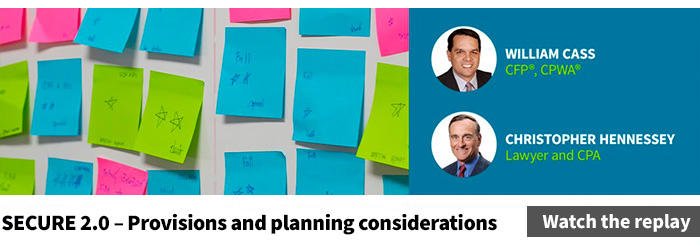New Roth strategies, easing rules around RMDs, changes in qualified charitable distributions (QCDs), and enhanced tax credits for start-up retirement plans were among the leading topics discussed by financial advisors in our recent webinar.
During the webinar, “SECURE 2.0: Provisions and planning considerations,” nearly 1,000 financial professionals heard about key provisions of the new law and its implications for financial and retirement planning.
Financial professionals: If you missed our webinar on SECURE 2.0, watch the replay here.
Here are some of the top questions from advisors. Note that the answers provided are based on our current understanding of the legislation, subject to change in the event the Treasury Department provides regulations or additional guidance.
Transfer of unused 529 college savings plan funds to a Roth
SECURE 2.0 allows up to $35,000 in unused funds from a 529 plan to be transferred to a Roth IRA. How might this apply in the case where a parent holds 529 plans for multiple children?
The $35,000 lifetime limit is per beneficiary. If a parent owns a 529 plan for each child as beneficiary, up to $35,000 may be transferred to each child assuming requirements are met.
If there are unused funds left in a 529 plan account, can a parent change the beneficiary of the 529 to themself and subsequently transfer funds to their own Roth IRA?
Conceivably yes, although it is unclear at this point whether a change in beneficiary would trigger a “reset” of the 15-year requirement for the 529 to be established before a transfer to a Roth IRA can occur.
One-time qualified charitable distribution (QCD) of $50,000 to a charitable trust
Could the IRA owner use the new QCD option to transfer IRA funds to an existing charitable trust?
No, the trust must be funded exclusively by a qualified charitable distribution. Additionally, the trust can only benefit the IRA owner and spouse (i.e., the trust cannot contain a provision that may benefit other family members).
Catch-up contributions for those with wages exceeding $145,000 the previous year must be made into a Roth account within the plan
Does this new requirement apply only to the new catch-up contributions available at age 60, or all catch-up contributions? (i.e., including catch-up contributions upon attaining age 50)
Yes, it applies to all catch-up contributions within qualified employer retirement plans (i.e., does not apply to IRAs).
Increase in the RMD age to 73 this year and eventually to age 75 in 2033
With the RMD age increasing, does this change the age to make a qualified charitable distribution (QCD)?
No, the age requirement for a QCD remains at 70½.
Enhanced tax credits for start-up retirement plans
Does the tax credit for start-up retirement plans apply to SEP or SIMPLE plans too?
Yes, in addition to 401(k) plans, new SEP and SIMPLE plans would be eligible for the tax credit.
If business owners currently offer a SEP or SIMPLE IRA to employees, can they benefit from the start-up tax credit if they switch to a new 401(k) plan?
No, the tax credit is not available if employees were covered by a retirement plan (including a SEP or SIMPLE IRA) sponsored by the business owner in the last three tax years.
Financial professionals: If you missed our webinar, watch the replay here.
For more information on SECURE 2.0, read “SECURE 2.0: Key provisions and planning considerations.”
332674
For informational purposes only. Not an investment recommendation.
This information is not meant as tax or legal advice. Please consult with the appropriate tax or legal professional regarding your particular circumstances before making any investment decisions. Putnam does not provide tax or legal advice.








